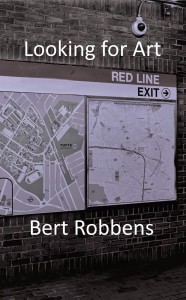
The past informs the present. And in the mystery novel based in Somerville Looking for Art by Bert Robbens, the ghost of Somerville’s past haunts the present day landscape. Robbens mines the milieu of the 60s and 70s Somerville, the very one that spawned the likes of Howie Winter and the Winter Hill Gang, and other assorted thugs. His story involves the men and women from that crowd and its ilk who remain around today, and the younger folks who heard the stories, the myths, the hype, and the brass tacks.
Looking for Art is also a lament for the old city; a city that is being transformed by the rapid-fire pace of gentrification. The author captures the generational conflict, the old grudges, through excellent characterization and snappy dialogue that rings true. His characters are shades of gray—not black or white. They can be walking contradictions—like we all are.
 The plot concerns the protagonist Joe, an ex-cop, who has lived in Davis Square all of his forty years. Joe is contacted by a former Somerville resident, Eileen, who now has a cushy job and a home in the tony suburb of Lexington, Mass. She hires Joe to find her missing father Art. Art, back in the day, was involved in the gang wars in Somerville, and now is in hiding as his unsavory past comes back for its pound of flesh. Joe, a street smart, self-styled gumshoe, could be in a Raymond Chandler novel. He talks tough, but inside he has an acute sense of his own failings as well as a sense of decency and honor.
The plot concerns the protagonist Joe, an ex-cop, who has lived in Davis Square all of his forty years. Joe is contacted by a former Somerville resident, Eileen, who now has a cushy job and a home in the tony suburb of Lexington, Mass. She hires Joe to find her missing father Art. Art, back in the day, was involved in the gang wars in Somerville, and now is in hiding as his unsavory past comes back for its pound of flesh. Joe, a street smart, self-styled gumshoe, could be in a Raymond Chandler novel. He talks tough, but inside he has an acute sense of his own failings as well as a sense of decency and honor.
Obviously, Robbens knows Somerville well, and can describe an old tavern, a slightly gone-to-seed Somerville home, and the trendy newcomers to our city, with right on accuracy. On the first page of the novel Robbens gives a description of The Old Town Tavern—that gave me the look, the feel, the taste of any number of gin joints I frequented in our burg:
“ The Old Town Tavern had been a fixture in Somerville for more than fifty years. The building had been there for a hundred. Most of the interior hadn’t changed. The dark wood floor was original, as was the stamped tin ceiling. The bar was heavy wood, inlaid with some kind of textured black plastic. It had probably been installed when the tavern had taken over the space. It was all good material and workmanship, but it had seen a lot of service. The Yuppies would have taken over the place and called it ‘shabby chic’ if they been stiff-armed by the townies who considered it their turf.”
Since I am a long-time denizen of Union Square, and I have heard the hype of the wonderful new gleaming city that the new subway will bring, I was particularly affected by this passage where Joe ponders the plight of Brazilians immigrant and his own shaky future:
“ They were doing what generations of Somervillians had done before, what his own grandparents had done. The came here to work and make a better life for themselves and their families. As he saw it, that was what the city was for, part of its fundamental nature, and something to be proud of. The Brazilians didn’t organize massive criminal businesses to bleed the city dry…and they weren’t Yuppie colonists taking over in the name of Starbucks and sushi. But he feared for them, just as he feared for himself and the rest of his old time working class neighbors. Slowly, but inevitably, they were losing their grip on the city. Economic forces and changing tastes were forcing them out. The Brazilians would find a someplace to go, someplace with cheap housing and jobs, someplace where enough of them can gather to feel comfortable, a new home. For Joe, it wouldn’t be that easy. Somerville was his home. For him, there would be no other, not in his lifetime. If he went somewhere else—anywhere—he would be a stranger. The only thing he could do was hold on to his home as long as he could, until it changed so much it was no longer home.”
Robbens keep the plot moving in this book with quirky characters and Somerville archetypes. This is more than a mystery—it makes a political and sociological statement about so called ‘progress’ and what is left in its wake.















Reader Comments